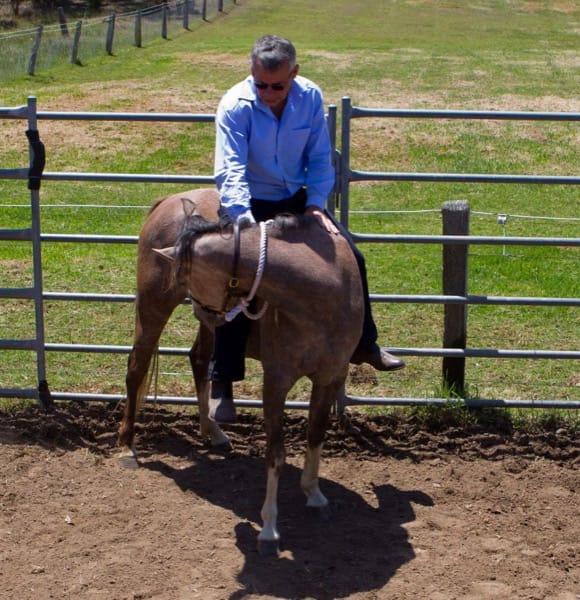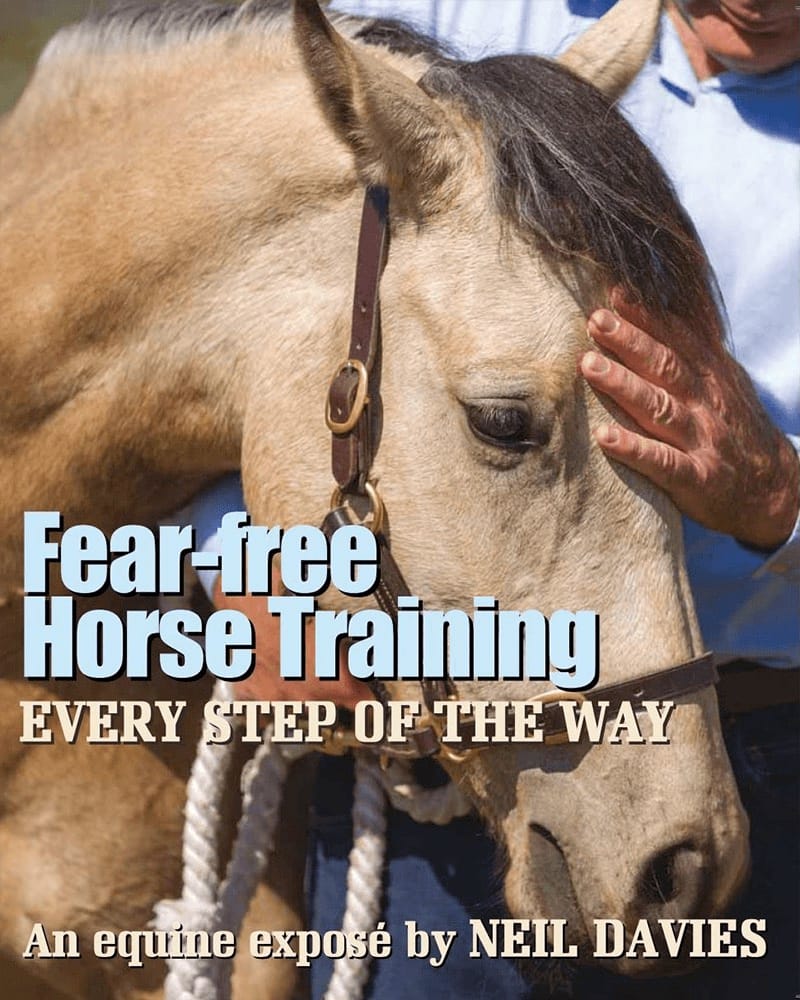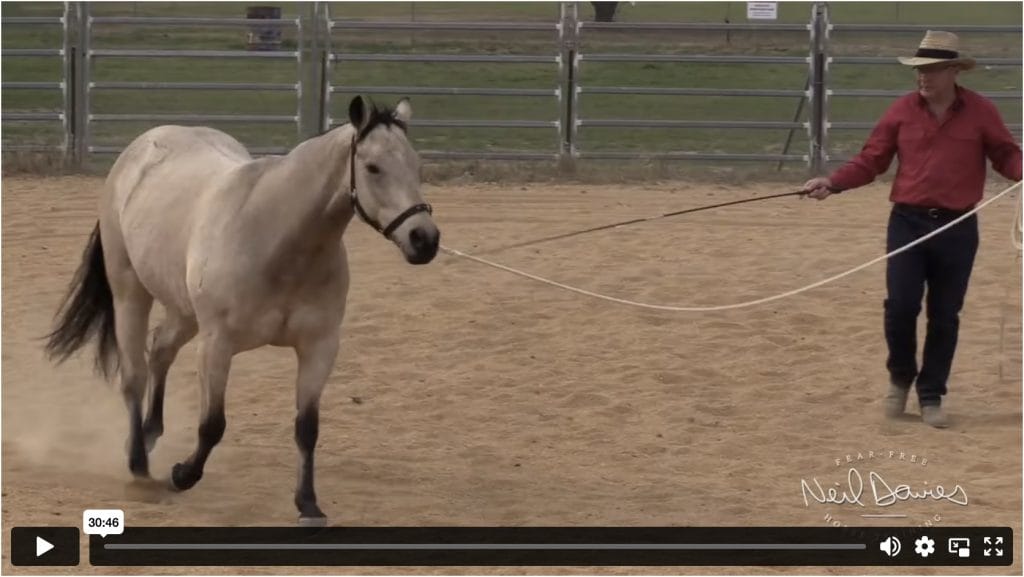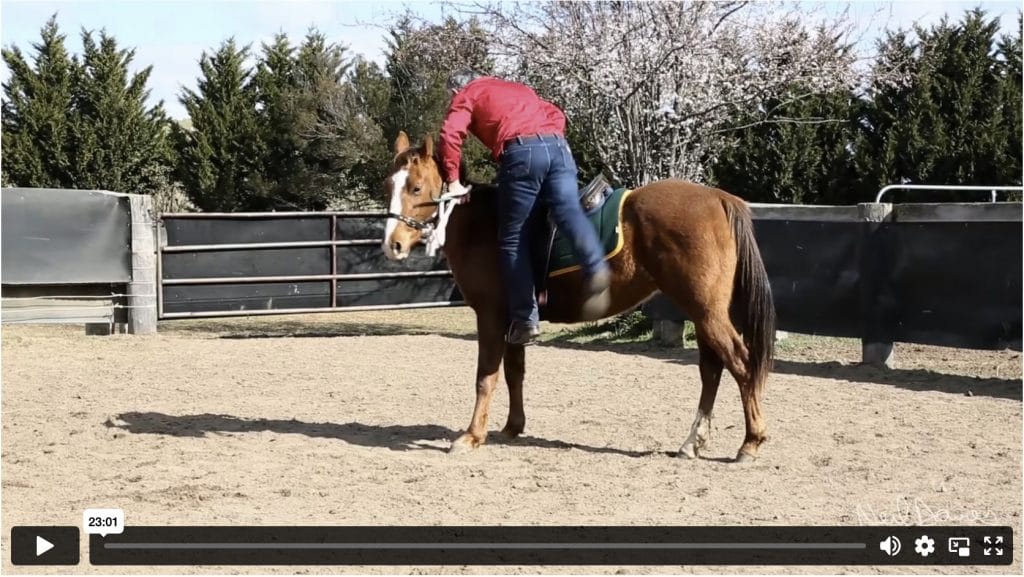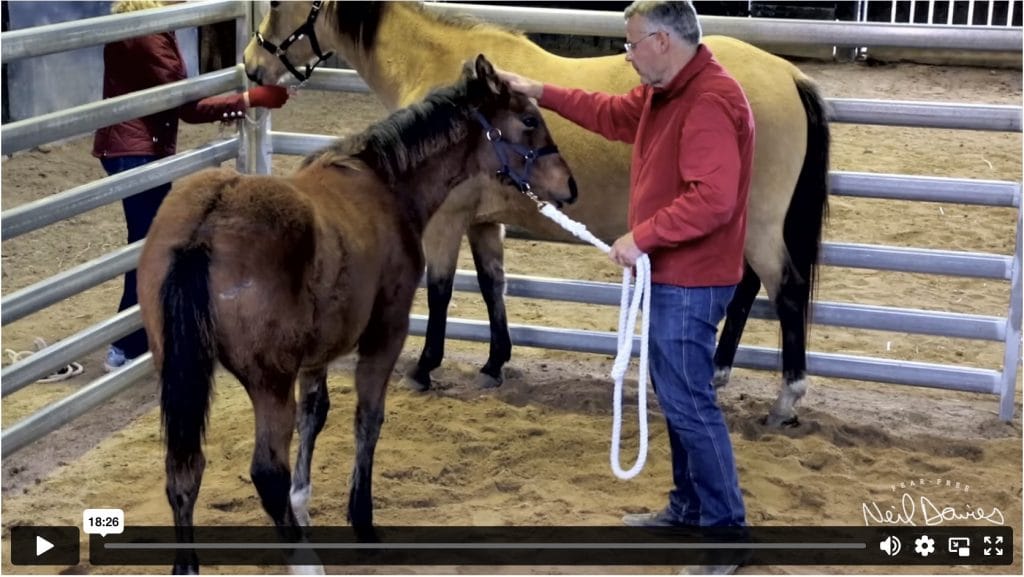In my opinion, advance and retreat is the key to introducing everything to every horse without frightening them.
Equally, when a horse has previously been frightened by a specific item, advance and retreat must be used to overcome the bad experience.
When advance and retreat is used, two components of learning theory are at work:
Negative reinforcement and shaping.
- Negative reinforcement.
Definition:
The subtraction of something aversive, (such as pressure) to reward the desired response.
Negative reinforcement plays a large part in advance and retreat.
Take the example of starting a young horse under saddle.
When a trainer first rubs his arm over a young horse’s back, the horse is worried and under pressure.
The trainer’s arm on the horse’s back is, at first, aversive.
When the horse stands for a few seconds – the desired response – the trainer takes his arm away and the pressure is relieved or ‘subtracted’.
Negative reinforcement has taken place.
When a trainer lies across a horse’s back for the first time, the horse is worried and under pressure.
When the horse stands for a few seconds, the rider dismounts and steps away, and the pressure is relieved.
Negative reinforcement has taken place.
- Shaping.
Definition: The successive approximation of a behaviour towards a targeted desirable behaviour through the consecutive training of one single quality of a response followed by the next.
Not paying due attention to shaping in horse-training has been associated with conflict behaviours (Morgan, 1974; Mclean, 2003).
When a trainer starts a young horse under saddle, the targeted desirable behaviour is for the horse to accept a rider sitting on his back.
This is achieved by consecutive training responses.
First is the acceptance of the trainer’s arm rubbing over the horse’s back.
Next is the acceptance of the trainer lying across the horse’s back.
Next response is the acceptance of the trainer’s leg and knee moving to the top of the horse’s back.
Consecutive training responses continue until the trainer sits upright on the horse’s back.
Acceptance of a rider sitting on a horse’s back must be shaped in small increments.
The distance that the trainer moves is increased on each approach.
The time the trainer spends in each position is also increased on each approach.
As stated in the definition:
‘Not paying due attention to shaping in horse-training has been associated with conflict behaviours’.
Without the correct use of shaping, the horse will become confused and frightened when a rider is first introduced; the horse will buck or rush away.
Habituation as I see it.
Habituation is defined as:
The waning of a response to a repeated stimulus as a result of frequent exposure (not fatigue).
Trainers often say that horses must be habituated to anything new.
However, a horse that is repeatedly exposed to a stimulus, without regard to negative reinforcement and shaping, will become confused and frightened.
Conflict behaviours will arise and the horse will rush away, buck, kick, rear, strike or use some other form of defence.
Before a horse can relax, he must know how to relieve pressure.
Prolonged exposure to a repeated stimulus means that the horse has no way to relieve pressure.
He’ll become confused and frightened.
The horse cannot relax without the correct use of both negative reinforcement and shaping.
When advance and retreat is used to mount a horse for the first time, the horse is not being habituated to a rider.
Instead, the horse is being taught how to get rid of pressure i.e. the rider from his back.
See this demonstrated in my Starting a Horse Under Saddle Online Clinic.
With the correct use of shaping and negative reinforcement, the horse learns to stand still and wait for the rider to dismount.
Then the horse can relax because he has a way to relieve pressure.
Here’s a quote from a paper titled Punishment in horse-training and the concept of ethical equitation by Paul McGreevey BVSc, PhD, MRCVS, MACVSc (Animal welfare) and Andrew N. McLean, BSc, PhD.
…..gaining control over aversive stimuli is of vital importance to animals.
When such control is thwarted, the animal’s well-being is threatened and neurosis may develop.
Hence, extra care must be taken when training animals using aversive stimuli because of animals’ imperative to achieve control over such stimuli. Solomon (1964) showed that maladaptive behaviour arises when:
- There are sustained raised levels of arousal;
- The aversive stimulus is unpredictable;
- The aversive stimulus is uncontrollable; and
- The aversive stimulus in inescapable.
Numerous studies attest the problems that emerge when these conditions arise…
The four points noted by Solomon occur every time a horse is exposed to frequent and repeated stimuli without any way to relieve pressure.
A horse’s response will not wane by frequent and repeated exposure to a stimulus.
A horse’s response will wane only when he knows how to relieve pressure.
Far too often, horses are exposed to frequent and repeated stimuli from flags, tarps, ropes, saddles and other paraphernalia without any way to find relief.
Such practices should never be used with any horse.
It’s time to put every horse’s welfare at the forefront of every training regime.
See how every horse should be started here

